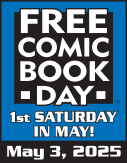The Long Road To Change: An Interview With The Creators Of March
Sep 24, 2013
 |
|
Lesson Plan To help teachers use March in class, |
Congressman John Lewis has been a pioneer in Civil Rights since the earliest days of the movement. The last surviving member of the Big Six leaders (which included Dr. Martin Luther King, Jr. and Roy Wilkins), Rep. Lewis has been on the front lines of massive social change.
In August, Top Shelf Productions released March Book One ($14.95, 978-1-60309-300-2) the first volume in a trilogy chronicling Rep. Lewis' life and experiences. Beginning with his childhood growing up in rural Alabama during the days of segregation, March takes readers alongside Lewis through his involvement in Civil Rights actions such as the sit-in protests in Nashville, the Freedom Rides, and the seminal March on Washington for Jobs and Freedom (where Dr. King delivered his "I Have a Dream" speech). Volumes Two and Three are set to be released in August of 2014 and 2015, respectively.
March is co-written by Andrew Aydin, who works on Rep. Lewis' staff handling Telecommunications and Technology policy and is a lifelong comic fan. It was Aydin's insistence that convinced Lewis to participate in creating the graphic novels.
The art for March is provided by Nate Powell, a New York Times bestselling artist whose work includes the Eisner and Ignatz Award winning Swallow Me Whole from Top Shelf and The Silence of Our Friends from First Second. In 2011, Powell addressed the United Nations to discuss his work on the fundraising anthology What You Wish For: A Book for Darfur.
March Book One received an unprecedented amount of media coverage, as the creators toured extensively for the book over the summer. BookShelf has compiled a list of Rep. Lewis, Aydin, and Powell's media appearances, including appearances on The Colbert Report, the ALA Annual Conference, and Book Expo America.
BookShelf spoke with each of the creators of March about their involvement in the books, and what brought each of them to work on this historic project.
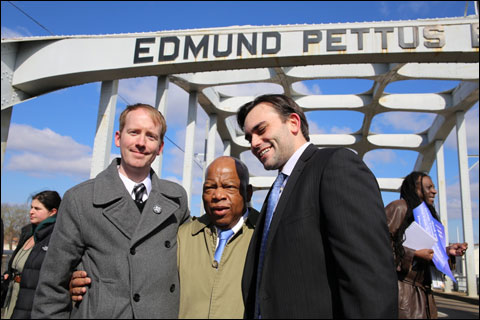 |
| (l-r): Nate Powell, Rep. John Lewis, and Andrew Aydin at the Edmund Pettus Bridge |
Rep. John Lewis
You've written two books previously [one of which was Lewis' autobiography - Ed.]. What made you decide to write a graphic novel?
A few short years ago, Andrew said to me, "Why don’t we consider doing a graphic novel?" and I sort of put it off. And then my mind went back to 1957, The Montgomery Story, telling the story of Martin Luther King, Jr. and the bus boycott, and how they did it with the comics, and making it easy for young people to understand the power of nonviolence, the power of direct action, and peaceful resistance. And I finally said, "Yes, let's do it," because I saw the need to try to educate and inspire and get more young people motivated to do something about all of the violence in our society and to let them know that during another period in our history that a group of young people had the courage to use the way of peace, the way of love, the way of nonviolence to bring about change. It’s a successful technique, a successful philosophy, and it’s a way out.
Had you read The Montgomery Story when you were young?
Yes, it came out in 1957. I was 17 years old, and I grew up fifty miles from Montgomery. It was so inspiring to read it, and later, in the fall of 1959 and part of 1960, I read it over and over again, and that's what lead me to start attending the nonviolent workshops as a student in Nashville, and it changed my life.
How did you decide to work with Nate Powell?
I knew of his work, every Sunday I would see the listing of books in the New York Times book review, and his name kept popping up. Then I had a discussion with Andrew, and Andrew said Nick Powell is the person. He's a wonderful, wonderful young man, and he's so talented and so gifted. 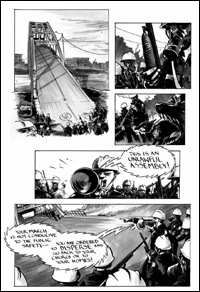 What was it like when you saw his art for the book, when you saw the events from your life drawn out on the page?
What was it like when you saw his art for the book, when you saw the events from your life drawn out on the page?
Seeing the drawings and the work of Nate, I saw myself. I was moved – I felt like he did a great job, and unbelievable job in describing and illustrating me as a young boy growing up in rural Alabama during the Forties and the Fifties, and later as a student in the sit-in movement and the Freedom Rides.
I think it sends a message to young people that you, too – it doesn't matter how young you are, that you too can get involved, that you, too can make a contribution. Where you come from, where you find yourself in life, you can lead on with a dream, a philosophy, and you can do something to make a contribution, to bring about change.
The framing of the story shows you getting ready to attend the inauguration of President Obama. Having been at the roots of the Civil Rights movement and watching the country progress since then, how far do you think we’ve come, and what areas do you see where there could still be improvement?
We have come a distance. We have made unbelievable progress. When I was growing up, I saw those signs that said "white" and "colored." "White men", "colored men", "white women", "colored women", "white waiters", "colored waiters" – those signs are gone, and they will not return. The only places we would see those signs today would be in a book, in a museum, on a video. But if someone had told me when I was being arrested and beaten, often bloody and sometimes unconscious, that one day I would live in a country like America and see a person of color elected president, I would have said "you're crazy, you're out of your mind, you don’t know what you're talking about." So when people said to me nothing has changed, I just try to say come and walk in my shoes, and I will show you change.
We still have to deal with issues of poverty and hunger that affect a large segment of our society. It doesn't matter if people are black or white or Latino or Asian American or Native American, there are still too many people that are left out and left behind. And we've got to end discrimination based on sexual orientation, and be prepared to take that great leap and create a new society that is at peace with itself.
When you were in the movement, especially in the beginning, did you have a sense that what you were doing was going to cause such a significant change?
At the time of my involvement, whether it was the sit-ins in Nashville or going on the Freedom Rides, marching on Washington fifty years ago, or marching from Selma to Montgomery for the right to vote forty-eight years ago, I had some idea that we were involved in a movement, a big movement, a powerful movement for change, but I didn't have any idea at the time that it would have the impact that it had. You travel around America, or you travel around the world, the great majority of people know something about the Civil Rights movement. Students are studying the philosophy behind the nonviolence. Elementary school students, high school students, not just college students. And you travel around the world, people know "We Shall Overcome," they know something about Dr. King's "I Have a Dream" speech.
What would you like readers to take away from the book?
I would love readers to read and understand that another generation of people, just ordinary people, believed deeply and they were moved to act. To speak up and speak out, and they had raw courage, enough courage – literally – to put their bodies on the line. That people were prepared to die for what they believed in.
Andrew Aydin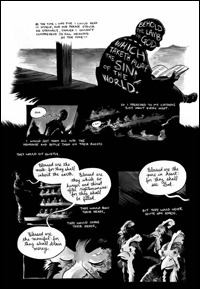 How did you come to work with Rep. Lewis?
How did you come to work with Rep. Lewis?
I wanted to move to Washington to live closer to my mom and hopefully work on Capitol Hill. I got lucky. He had an opening. That was about six years ago.
I've read that you were inspired to create the graphic novel March when you discovered the Montgomery Story comic book. What was it about that comic that had such an impact?
Martin Luther King and the Montgomery Story had a huge impact on me. I ended up writing my grad school thesis on it. There was a story that ended up being true that one or two of the Greensboro Four were inspired to sit-in after reading it and I was captivated by the idea of a comic book having such an impact. I was moved by the concept of comic books as a vehicle for inspiring social change.
What was the collaboration process with Rep. Lewis and Nate Powell like?
The collaboration process has been a lot of late nights and long weekends but it has been a wonderful experience to work with both of them.
Congressman Lewis is an incredibly important figure in American history but he's also a really kind, thoughtful person. Working with him, hearing his stories, helping him tell his story in a new medium--it has been very special. It is an experience I will treasure. I hope that I have done everything I can to honor Congressman Lewis' sacrifice and that of so many of the real people in the story we are trying to tell.
And I was a fan of Nate's work before I ever met him or knew I'd be working with him. I couldn't have asked for a better collaborator to work with. I learned so much from him about the process of making comics.
I'm really excited to continue working with them on the next two books.
What was your experience with comics prior to this project?
I've always been a big fan. I started reading comics when I was eight or nine. By the time I was in high school, a friend and I were such regular readers that we arranged for our study hall period to be the last class of the day on Wednesdays so we could go to the store early.
But I'd never written a comic book or a graphic novel before. I'm basically a fanboy who managed to live the childhood dream.
What made you decide to go with Top Shelf as a publisher?
I am a big fan. I first got hooked on them reading (Alex Robinson's) Box Office Poison. Honestly, I was pretty humbled they were interested in the idea. I'll never forget when I got the phone call from Chris Staros saying that he had read our script and wanted to publish it. I was in the front yard and I started dancing all around. My neighbors must have thought I looked pretty silly but it was one of the greatest moments of my life.
What do you hope readers will take away from March?
I hope everyone that reads March comes away with a little inspiration. John Lewis is a hero and I think these days we need some real heroes to look up to. But I'm also hopeful that people will want to learn more about nonviolence. Maybe, just maybe, someone will read March and get inspired to go and do something.
Nate Powell
How did you come to be involved in this project? How does it feel to work on this?
Chris Staros called me up in the spring of 2011 to fill me in on the project-- Congressman Lewis and Andrew already had a finished first draft of the script, and Chris thought I'd be a good fit as artist. Working on this story conjures many emotions in the course of its production—it's a deep honor, of course, but the more I work through it, the more I begin to grasp the importance of imparting this chapter of history to subsequent generations of folks who will be further removed from feeling directly connected to the movement, or its impact, as the years go on.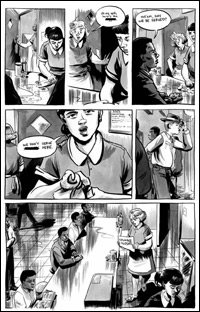 Did you approach the art for March any differently than other projects?
Did you approach the art for March any differently than other projects?
The primary difference is the issue of faithful representation. This is a story of John Lewis' life, sure, but it's also the account of an earth-shaking social struggle in which many people were involved. With that in mind, I try to present this memoir with a balance between hyper-subjective personal experiences and the broader social context through which to place John's story. My own books are very focused on sensory information, on small moments and the vividness of experience and memory, and I try to pull those moments into focus whenever possible, staying as close to these "characters" as I can. There's certainly a lot of back-and-forth with the writers, my editor, and occasionally Andrew has to run certain elements by a Congressional standards and ethics committee, as John Lewis an active member of Congress, subject to their own guidelines.
What sort of research did you for this book?
Congressman Lewis has quite an archive of visuals (and physical relics in his office), which Andrew has been good about providing to me along with each section of script. On top of that, I spend a good chunk of time referencing more subtle indicators of time and place, fashion and technology being the most noticeable. Sometimes I insert my own background or incidental dialogue, and I'll check with my parents (who grew up in 1950s-60s Mississippi) about certain slang or word choices. It's important to note that John is an orator who's been telling some of these stories for 55 years, so it was crucial to read his memoir Walking With The Wind, compare events and details, looking for anything not included in the script that might help give a more complete picture. I also have several books of photography from the Civil Rights movement, 1960s lifestyle illustration books, some documentary DVDs of specific events, and the stories of my parents, grandparents, and my own past. The specter of the segregated South still existed in the early 1980s, as it does today.
You provided the art for The Silence of Our Friends, which also dealt with civil rights struggles in the 1960s. What drew or continues to draw you to this type of material?
A lot of people ask me this, and the plain answer is that I'm interested in human rights because I'm a human. (how could one not be?) After Swallow Me Whole, I felt I was ready to tackle some of my own Southern cultural inheritance, the monstrosity as well as the beauty. It took a while to be comfortable enough to write or draw about it, but doing a few short stories helped focus my energies. The Silence Of Our Friends was Mark Long's autobiographical tale, set geographically near Arkansas, but with a 15-year gulf between our childhoods. I was writing and drawing Any Empire at the same time, and comparing our separate childhood accounts, I'd be astounded by how much things had changed in those 15 years, and other times I'd be just as frustrated at how we're seemingly still living in the 1960s. Generally, I think part of comics' coming-of-age in American culture is its potential to deliver and expand on these specific elements of the American experience, enriching our dialogue with each other, and allowing folks to work through some of their own issues. It's also important to note how complete a generational shift there's been since my parents' time—the teenagers of today largely aren't aware of who Rosa Parks is, or what King's, Malcolm X's, or Lewis' contributions and struggles were, and in an increasingly conservative and frightening cultural landscape, it's a job that's gotta be done.
You recently accompanied Rep. Lewis on a tour of civil rights landmarks, including the Edmund Pettus Bridge. What was that experience like, especially after working on March?
It was truly profound, and deeply affecting. What was most impactful to me was the sense that, by walking the same streets and eating in the same church basements used by so many brave and dedicated folks, very little time did separate our lives in 2013 from the struggles of the mid-century. I grew up in Montgomery, Alabama during elementary school, but had a very different experience of the city as a suburban white child. Returning to the city 25 years later in a different (and more complete) historical context charged me with the feeling of life coming full-circle.
Most powerful were moments that seemed to cut through space-time: while visiting Dr. Martin Luther King, Jr.'s house, I leaned on his kitchen sink while listening to an audio recording (from the day before his assassination) in which he described the voice of God speaking to him in that very kitchen, as he debated fleeing town with his family amidst bombings and death threats. Placing my hands where his hands made a late-night pot of coffee was transcendent. These are icons and heroes, of course—but even more amazing is that they were just like you.



